Alice Fox is an artist with a background in physical geography and nature conservation which informs her artistic practice that has sustainability at its heart. Focusing on her personal engagement with the landscape and organic detail, she works with natural fibres, employing natural dyes, stitch, weave and soft basketry techniques to create surfaces and structures she combines with found objects. Taking an experimental approach to these found objects she is able to explore the properties, boundaries and possibilities of each. She sees this as a collaboration between the object and artist.
She works from her allotment and her studio in Saltaire, West Yorkshire which is where Court Spencer caught up with her to find out more about her practice.
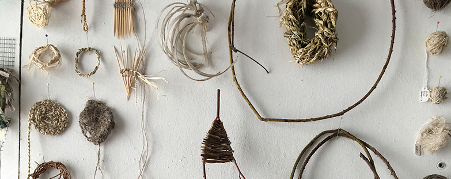
Studio wall with samples, 2020. Credit: Alice Fox.
Court: Thank you for having me over. It’s so nice to meet you! I first saw your work in 2019 at your graduation and have been following you on Insta for a while. I know you had given me the option to meet here in the studio or at the allotment. And with the snow this morning I’m very glad we agreed on the studio! I know the allotment was central to the work you made during your MA. Do you want to start by telling us a bit about that?
Alice: I took on the allotment when I started my MA in 2017, intending to use it as a focus for my practice-based research during the course and hopefully keep it going afterwards. I started using the plot to explore ideas around self-sufficiency in materials for my work, aiming to source all my making materials from the plot. It runs as a normal allotment, in that I grow fruit and vegetables, but I also make use of the plant fibres, sources of botanical colour and found objects available there. I grow some flax each year, which I process into fibre and spin into linen thread. I also make use of some of the plants growing wild around the edges of my plot, including nettles, bramble, bindweed and dandelions. I use all of these for constructing surfaces and structures, often combining them with found objects.
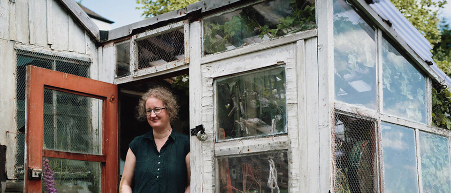
Alice Fox at Plot 105, 2021. Credit: Sarah Mason.
Court: So I suppose your work really follows the seasons. How do you split your time here and at the allotment?
Alice: I have been in my current studio for a few years now and yeah, I find my activity here relates to seasonal patterns. I tend to work much more regularly at the studio in the winter months, because there is less to do at the allotment, and it is less hospitable there. And I am away teaching more frequently during the rest of the year. During the pandemic I have been working at home more and have set up a home studio in my daughter’s bedroom, so the rhythm of working in my main studio is less regular. When I’m at the allotment, my focus is attending to the gardening activity that is most pressing, but during the summer and autumn I also spend time gathering and processing materials there as much as possible. These materials are then dried and stored for future use, especially during the winter. At least that’s the aim!
Court: You initially did a degree in Geography and worked in conservation. How did the change to art come about?
Alice: Yeah, my first degree was in physical geography, and I worked in nature conservation for a few years. When I had small children, I left that job because it didn’t work so well with family life. I then returned to art, took an adult education class in textiles and then decided to do a part-time degree at Bradford School of Arts and Media. I graduated from that in 2011 and have been working as a full-time self-employed artist ever since.

Plot 105: Mapping Materials, 2019 (detail). Pencil and botanical inks on paper with constructed objects: beech wood, daffodil leaves, apple wood, grown and processed flax, processed and spun nettle fibre, bramble, found wire, ceramic, plastics, cloth and paper. Credit: Matt Radcliffe.
Court: That’s brilliant! I know sustainability is a constant theme throughout your work. Can you say a bit about how that underpins your work, the practicalities and how it informs the work you make?
Alice: My interest in landscape and the environment are life-long and that first career really underpins the way that I work now. I feel it’s important that my activity is as sustainable as possible. My life isn’t perfect in that respect but in areas that I can control, including my artistic practice, I do as much as I can to have a low impact environmentally. Sourcing my materials by growing and gathering them myself has become a key part of that.
Getting to know and interacting sensitively with a small patch of land allows me to develop a deeper understanding of what grows, how and why, and what potential there is for me to make use of and honour these plants. Being involved in every stage of the growing, harvesting, processing and then using of fibre provides multi-layered understanding and meaning in the objects that I make. There are lots of practical limitations to working this way, but I also appreciate the boundaries that I set myself and find that can push me creatively.
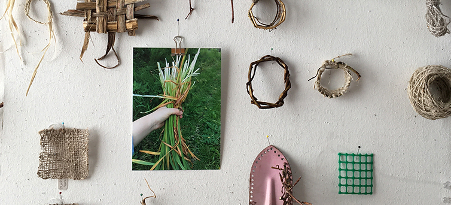
Studio wall with samples, 2020. Credit: Alice Fox.
Court: I completely agree that boundaries can help push your approach. I’m also loving how beautifully curated your studio space is and the series of publications you have. How long have you been making publications for?
Alice: I made my first self-published book when I did a residency at Spurn Point, East Yorkshire in 2012. For each major project I’ve done since then I’ve published a new book. They follow a similar format, but I’ve learnt each time I’ve done one and they vary – some are more of an exhibition catalogue, some explain the story behind the work. My most recent one ‘Plot 105’ has a written essay and a photo essay that outlines my engagement with the allotment. I have self-published seven books to date. I have also written two books for Batsford, the second of which will be published later this year.
Court: Do you tend to work in these projects or series? And how do these projects come about?
Alice: I see all of my work as a series – one thing leads to the next, always moving on. We tend to present work as ‘projects’ either for exhibition or because they fit in with some sort of brief or commission. But it’s all part of an ongoing continuum really. Some ‘projects’ are self-led or the result of an invitation to work to a brief or towards a specific aim.
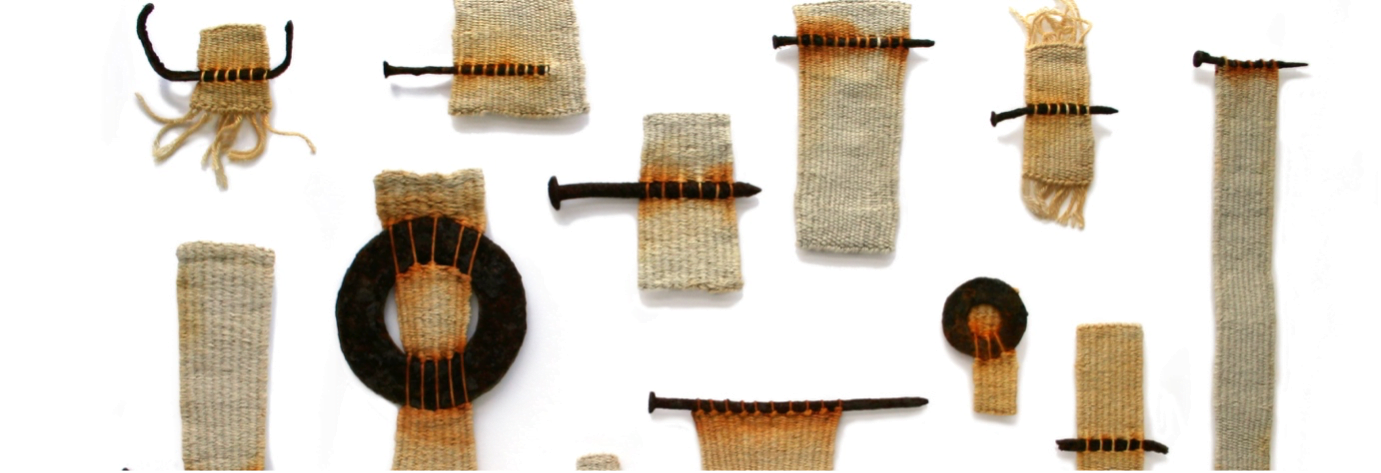
Tide Line – group (detail), 2013. Tapestry weave in cotton with found objects and rust staining. Credit: Alice Fox.
Court: You mentioned that the first publication was made during a residency. Can you tell us a bit about the residencies you’ve done and how these have shaped your practice?
Alice: I was artist in residence at Spurn Point in 2012. The residency was for 6 months and then the work toured for a further year. I got Arts Council funding for this and the whole thing was a massive learning curve. I’d not long finished my textiles degree and this project gave me the framework to figure out how to manage my own practice. I used beachcombed objects from the coast at Spurn for printing, using the sea defences and the sea to tie-dye cloth, developing a way of working with found objects (especially rusty ones) which was sensitive to the site, experimental and that could be combined with various other techniques. I learnt how to manage my time and create a body of work for exhibition; learned how different galleries work and how to organise and manage a tour; learnt how to publish a book, market and publicise all the aspects of the project. Looking back, I realise how big an undertaking this was for a new graduate, but I also used transferable skills from my previous job. It really set me up as a practicing artist and led on to all sorts of other things.
Another residency opportunity came through the Fifth Sized Book Project at Newcastle Central Library in 2017, which I was one of the lead artists for and which has led on to other things. Having a foot in different worlds can be really stimulating and I sometimes feel that I lurk on the edge of different media: handmade books, basketry, printmaking – all things that I take certain techniques from but then use in unconventional ways and with my textile skill set as the core.
Court: What do you think have been some of the decisions you’ve made or things you’ve put in place that have helped move your practice forward?
Alice: The Spurn project really kicked things off. I also had opportunities early on through the Quilters Guild Graduate Showcase, which led to invitations to exhibit, speak and teach. I’ve always been quite open to different opportunities, but I’ve also learnt when it is important to focus and say no to things. I apply for juried exhibitions, which can be soul destroying when you don’t get selected. But I’ve also learnt not to take it personally and just keep plugging away. Undertaking my MA helped me find a slightly re-aligned focus at a point that was really necessary. It’s good to seek advice regularly and I’m grateful for support I’ve had through various mentoring and funding schemes. I’m open to where things might go next, but also reflect on what fits with my core values. I wrote a statement of creative goals when I stated the MA and I come back to this again and again, checking in with how things fit.
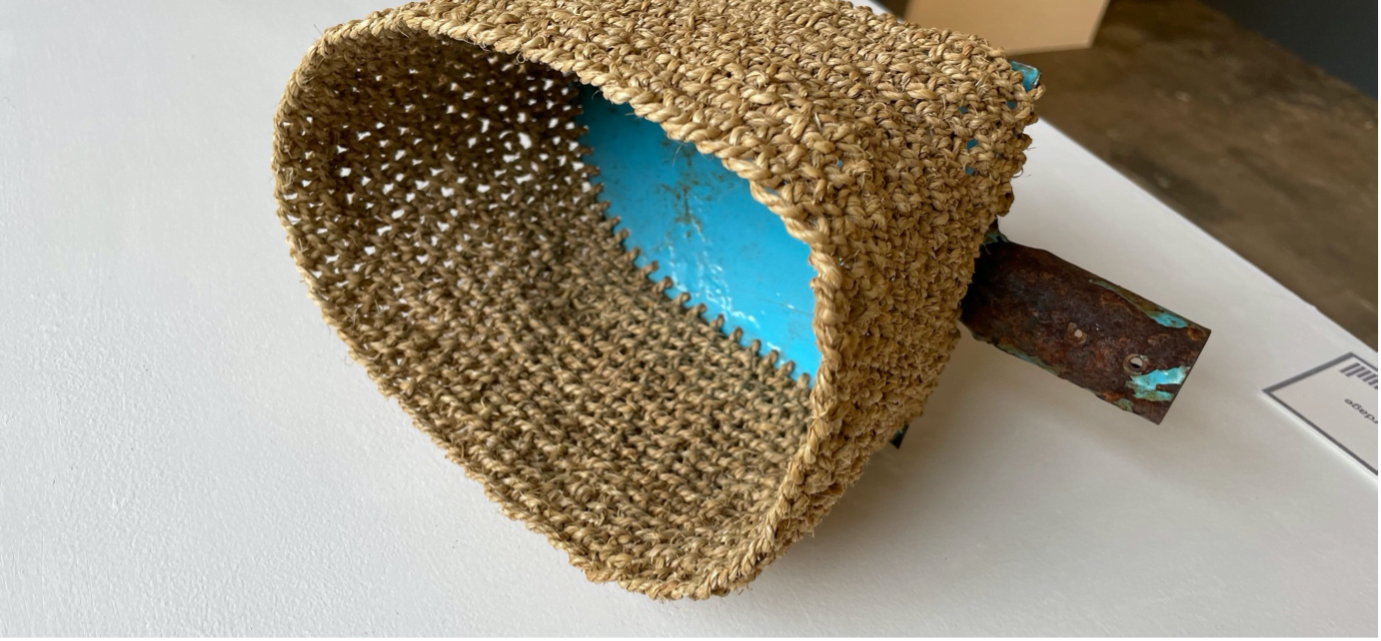
Hybrid 3: Blue Spade, 2021. Looped bramble fibre cordage with found tool. Credit: Court Spencer.
Court: That statement really helps you ensure projects feel right and that they align with your values. What projects are you working on at the moment?
Alice: I’m at the early stages of a number of different projects for exhibitions next year and the year after, so currently have thoughts and ideas bubbling away for a few things. I’ve recently been taken on by Jaggedart in London, with work showing at Collect this year and I’m planning new work for them to show. I am publishing a book for a collaborative project called Dovetailing and bringing together an artist’s book for Chrysalis Arts as part of their Five Hectares Project. As usual, I am juggling a number of different things.
Court: Well you definitely sound busy. What would you say has been your career highlight to date?
Alice: I was part of a project in 2019 commissioned by TOAST and Kettles Yard, Cambridge. The exhibition was short, but to be invited to make and show work in that location was really special. And recently, having work on show at Somerset House as part of Collect was another very proud moment but hopefully the start of new things too.
Court: Have you got a dream project you would like to make happen at some point?
Alice: This is a tricky one. I feel really satisfied with the way I am working at the moment, although I would love to have more dedicated studio time. If we’re really dreaming, then I would love to go on one of those expeditions to the arctic (or similar) where artists and scientists are brought together to respond to the extreme environment and changes occurring.
Court: Oh yeah, that would be amazing! My Dad worked for the Bureau of Meteorology and spent several years in the Antarctic. The photos and stories he came back with were incredible. What’s the best way for people to follow your work?
Alice: I use Instagram most regularly @alicefoxartist and all my exhibitions, workshops etc are listed on my website www.alicefox.co.uk
Court: That’s fab. Thanks again for having me over and letting me snoop through your studio. I absolutely adore your work and look forward to seeing your new projects come together!
Filed under: Art & Photography
Tagged with: art, climate, Craft, environment, green, growing, materials, sculpture, snooping through studios, studio visit, sustainability, thread
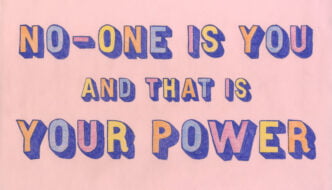
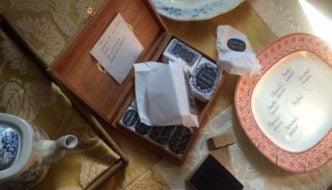
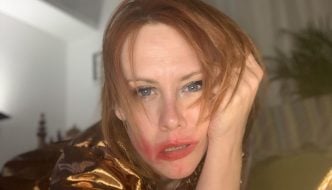
Comments